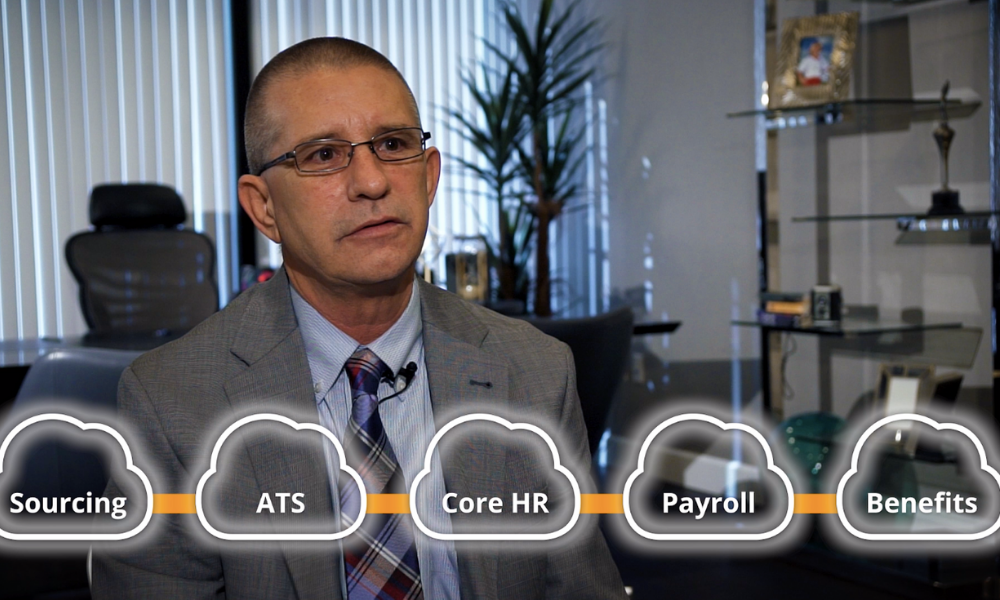
If your HR department still manually enters employee data from app to app, you can stop

HR departments love their apps. In fact, the average HR department uses 11 apps to source talent, track candidate applications, manage workers, pay employees, handle benefits, etc.
The problem? With HR apps, employee data sits in separate, disconnected silos in the cloud. Data integration connectors, like the kind created by Flexspring, solve this obstacle by seamlessly connecting data throughout your HR ecosystem.
Any workflow where your team currently passes papers between desks or manually re-enters data from screen to screen in HR apps can be streamlined with automatic data sharing.
For example, with a data connector, as soon as a hiring manager presses the hire button in your ATS, all employee data needed to process payroll is sent to your payroll app. Onboarding new employees becomes instant instead of requiring hours of manual double-data entry.
Depending on the amount of candidate data and employee records your company handles, data integrations can save several days of work per month to several month’s worth of effort each year.
Data integration frees HR professionals to concentrate on strategic work that grows your business. With data integration, your HR department can screen and vet candidates faster. Time to fill jobs reduces dramatically. As competition for quality workers increases, data integration is an inexpensive solution that helps your HR department work faster.
Real-time data integration also creates data continuity throughout your organization. Your HR team no longer has to wait for records to be entered, or check with others to see if they can run reports on updated data sets. With data integration, your HR team can focus on the strategic tasks that matter most.
One regional bank, Associated Bank, noticed an immediate productivity boost. “Flexspring’s Taleo Enterprise to Oracle HCM Integration is saving us 20-40 hours per week—essentially a full-time employee,” said Bob Simmons, SVP of HR applications. “We're getting great and very positive feedback from recruiters and from operations. They don't have to touch the records anymore or juggle paper forms for manual re-entry. Folks are happy to give up the drudge work. There's a feeling that this integration really makes a difference here.”
Tediously re-entering dozens of data fields from one app to another generally leads to typos and manual data-entry errors. Data integration greatly reduces errors. And in cases where you are re-entering payroll or benefits numbers, such as between payroll and ERP apps, it’s vital that all the digits are correct so everything balances.
Integrated Dermatology processes 250 payrolls a month from dozens of legal entities. Without automation, manually entering 250 payroll files each month from ADP to Oracle NetSuite occupied half of a full-time employee’s schedule and reduced productivity for this fast-growing medical company.
“We’re no longer in the manual payroll journal entry business. We’re no longer in the file upload business,” said Jeffrey Laymon, Executive Consultant, Integrated Dermatology. “With automation, we’re positioned for substantial, profitable growth without adding any strain or headcount to our back office.”
HR people would rather work on strategic things that grow a company rather than manual data entry. Everyone is happy to give up the drudge work. Young workers, in particular, are quickest to ask, “Can’t the computer do this for us?” With data integration, they’re right.
And with more HR professionals working from home, the last thing HR professionals feel like dealing with is manual data entry.
Data integration reduces the creation of unnecessary user accounts, duplicate employee profiles, and people involved with manual data entry.
With data integration, fewer people need to touch employee records, and fewer people are exposed to confidential employee data, thus increasing security.
Data integrations from Flexspring also do not store employee data. They simply pass the packets of information along secure connections.
Data integrations never take a vacation or need a sick day. Once enabled, data integrations and automations work around the clock.
With so many people working remotely from home, data integration ensures that workers always have access to the most recent data and don’t have to second guess reports, the status of a candidate, or a job posting.
Due to acquisitions, different locations, and legacy systems, many organizations rely on multiple HR apps to do similar jobs. It can be impossible for leaders to see the whole picture of their organization without comprehensive reporting from a unified data set.
Creating a unified data warehouse was the main goal of MAPEI America’s data integration project. “We are a global organization,” said Don Oleski, IT Director of MAPEI Americas. “We had too many silos and HR systems. So, our primary objective with the data integration was to centralize the data. Bring all our employee data into one portal. One access point to see the globe. The data integration has made us more effective. We can actually vet our candidates quicker and hire at a faster pace.”
Flexspring focuses exclusively on integrating HR applications. Any company that wants to save time and money—by avoiding manual double-data entry between HR apps—benefits from Flexspring’s services. Visit www.flexspring.com for more information about the apps that you want to connect.